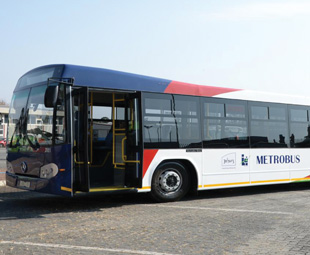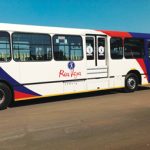Green buses gaining ground

A decade ago, the first hybrid buses in London entered service. CLAIRE RENCKEN explores the subsequent developments in terms of low-emission, more environmentally friendly buses
There are 1 500 hybrid buses, 22 electric buses and eight hydrogen buses currently operating in London – out of a total bus fleet of 8 600. The first hybrid bus was introduced in March 2006, and over 300 were in passenger service by July 2012. The world’s first double-deck hybrid bus was introduced in London during January 2007.
Hybrid-electric buses use a combination of an electric battery pack and a diesel engine to provide power, and produce around 40-percent less carbon dioxide (CO2) emissions than traditional diesel-engine buses. Energy generated during braking is used to charge the batteries of hybrid vehicles.
Other low-emission buses have also been used in London. Three buses powered by hydrogen fuel cells were used from 2004, but have since been withdrawn; eight are now operating on one of the routes. An ethanol-fuelled double-deck bus was operated by Transdev London in 2008 and 2009.
Transport is responsible for around 20 percent of London’s CO2 emissions; buses make up five percent of the transport total. Converting London’s entire bus fleet to hybrid vehicles would reduce CO2 emissions by around 200 000 t per year.
The city has set a target of a 20-percent reduction in emissions by the year 2020. Transport for London (TfL) has committed to the use of electric or hydrogen buses for all 300 single-deck buses in Central London, and the use of hybrid buses for all 3 000 double-deck buses in the same area. This is as part of the Ultra Low Emission Zone scheme.
 The introduction of hybrid vehicles in London has received praise from the Low Carbon Vehicle Partnership, which awarded TfL the first ever Low Carbon Champion Award for Buses in July 2010.
The introduction of hybrid vehicles in London has received praise from the Low Carbon Vehicle Partnership, which awarded TfL the first ever Low Carbon Champion Award for Buses in July 2010.
So, what about South Africa? Bus companies are aware of the relatively high carbon footprint being left by the bus industry, but also stress that the use of public transport reduces personal car usage (thereby reducing exhaust emission in that sector) and provides mobility to roughly 220 000 individuals on a daily basis.
We may not be on par with London, but the big players are addressing the issue. Take Golden Arrow Bus Services (GABS) in Cape Town, for example. The robust recapitalisation of the GABS fleet, through the acquisition of 500 new buses since 2002, has provided a basis for operational efficiencies and decreased emissions.
The latest model buses boast Euro-3 specifications that reduce exhaust emissions through the fitment of turbochargers, electronic fuel pumps and injectors, which contribute to efficient engine operations.
A further sustainable contribution is the attainment of the Green Building accreditation status of Golden Arrow’s newly opened Southgate depot. All aspects of the design and construction of this depot took cognisance of resource-efficient processes. The building features energy-saving lighting, solar-powered heating and air-conditioning. In addition, it draws its electricity supply from the wind-powered Darling grid.
In Johannesburg, Rea Vaya (the City’s bus rapid transit system) has also been lauded for its climate-friendly initiatives. About a year ago, Metrobus’s new fleet of energy-efficient buses was unveiled at the Milpark depot. The 70 buses included 40 new dual-fuel buses and 30 existing buses that had been rehabilitated and converted to use both diesel and compressed natural gas (CNG).
The ability to make it happen
The main benefits of these low-emission, alternative-fuel technologies is that they are less harmful to the environment. “Noise pollution is also reduced as the engines are quieter in operation. The tail-pipe emissions are lower than Euro-5 or Euro-6 engines with better fuel consumption,” says Shane Henry, head of Bus & Coach at Mercedes-Benz South Africa.
Henry adds that the maintenance requirements of these vehicles are also reduced thanks to the modern, cutting-edge technology, which reduces waste and makes them even more eco-friendly.
However, South Africa’s current legislation requires vehicles to meet only the Euro-2 standard, which was introduced in 1998. It significantly lags behind international trends.
Original equipment manufacturers (OEMs) are still doing their bit, though; offering the best technology and after-market assistance that they can to help local bus operators reduce their fuel consumption and emissions.
According to Isuzu, its buses boast product specifications that emphasise environmental performance, and are well positioned to meet the needs of bus operations, while also adhering to local regulations.
Similarly, Scania notes: “Scania’s commitment to minimising environmental impact goes beyond the vehicles running on the roads. From world-leading technological developments and efficient production, to cost-effective operation, optimised servicing and repairs, as well as responsible end-of-life treatment, Scania takes the entire vehicle life-cycle into consideration.”
Published by
Focus on Transport
focusmagsa




